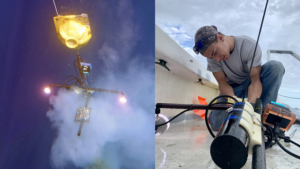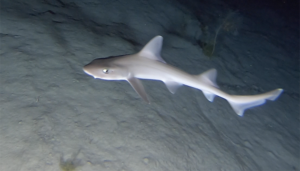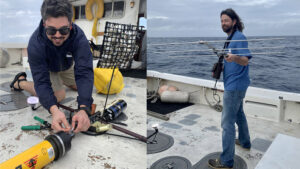Going to Great Depths

The project utilizes an instrument (left) called a “deep-BRUVS”—or a baited remote underwater video system that operates in deep water, which, for this project, is down to depths of 3,200 feet (1,000 meters). The deep-BRUVS combines a submersible fish survey platform with a baited underwater camera and lighting set-up. BIOS Bermuda Program intern Andreas Rattery (right) readies the deep-BRUVS for deployment in the field. [Photo credit: Kaitlin Noyes]
Now a team of scientists, led by BIOS research specialist Tim Noyes, is continuing the tradition of deep-sea exploration with a Bermuda-based study funded by a Darwin Plus grant through the United Kingdom’s Department of Environment, Food, and Rural Affairs. The two-year project, which began in 2021, uses a combination of video survey and molecular techniques to study the fishes that live in the ocean surrounding Bermuda at depths of 100 to 3,200 feet (30 to 1,000 meters). Understanding the distribution of these deepwater species in space and time is an essential first step towards effective management and conservation.

A new study, led by BIOS research specialist Tim Noyes, is using a combination of video survey and molecular techniques to establish baseline measures of biodiversity for deep-ocean fish in Bermuda, such as this dogfish. The project, which is funded by a Darwin Plus grant from the United Kingdom’s Department of Environment, Food, and Rural Affairs, includes collaborators from Beneath the Waves (a U.S. nonprofit), the Government of Bermuda Department of Environment and Natural Resources, the University of Rhode Island, and the Waitt Institute (a U.S. nonprofit currently working in Bermuda).
“This project will establish baseline measures of biodiversity in Bermuda’s deep waters and help infer connections between other ecologically sensitive habitats and the deep ocean,” Noyes said. “The data will then be available for comparison over time in order to track changes, particularly for species that are of conservation interest or those at risk of accidental capture by commercial fishing gear.”
Joining Noyes are collaborators Austin Gallagher, marine biologist with Beneath the Waves, a nonprofit ocean conservation organization based in Virginia; Brennan Phillips, ocean engineer with the University of Rhode Island; Joanna Pitt, marine resources officer with the Bermuda Government Department of Environment and Natural Resources (DENR); Kaitlin Noyes, director of education and community outreach at BIOS; and Shayna Brody, director of media and communication with the Waitt Institute, a nonprofit marine conservation and planning organization based in California. Together, the group brings expertise in ocean technology, marine conservation, shark ecology, fisheries management, science education, and public outreach.

To date, there have been 15 deployments of the deep-BRUVS, capturing over 75 hours of footage of Bermuda’s deep-ocean fishes. The project has recorded multiple encounters with moray eels (above), dogfish, and sixgill sharks. By the end of the project, a total of 72 deployments will have been completed.
Tools of the trade
Phillips’ academic interests include the development of novel, low-cost instruments that can be applied to deep-sea research platforms—or, as he calls it, “deep and cheap”. One such instrument is a miniaturized, compact camera system that can withstand the pressure exerted at depth. When attached to submersible fish-surveying platforms called baited remote underwater video stations (BRUVS), the result is a powerful, yet relatively inexpensive instrument, for collecting data in the deep ocean and other sensitive environments where traditional diver-based monitoring isn’t feasible.
Because the BRUVS are baited, they are particularly good at collecting data about highly mobile, predatory fishes, such as sharks. This is where Gallagher’s expertise comes into play. Beneath the Waves works around the world to leverage cutting-edge technology, such as Phillips’ deep-ocean BRUVS, to advance marine conservation, with a particular focus on sharks and marine protected areas (MPAs) – areas of the ocean set aside for conservation.
“Contemporary marine conservation efforts focus on protecting large portions of the ocean; however, we often have a poor understanding of the biodiversity we are trying to protect,” Gallagher said. “This is especially the case for the deep sea, and there is almost nothing known about the life histories of deep-sea sharks. This project will hopefully begin to fill in some of those gaps, by focusing on Bermuda’s deep ocean ecosystem.”
In mid-February, Gallagher spent a week at BIOS working with Noyes to begin the deep-BRUV sampling, successfully completing six deployments. An additional 10 deployments were performed in mid-March, when Phillips and Noyes were joined by Beneath the Waves’ program manager Christine de Silva.

Austin Gallagher (left), co-principal investigator and marine biologist with Beneath the Waves, visited BIOS in February 2022 to launch the project. [Photo credit: Andreas Ratteray] Tim Noyes uses an antennae and GPS to locate the deep-BRUVS once it sheds an expendable drop weight via an acoustic release system and returns to the surface. [Photo credit: Kaitlin Noyes]
The video collected by the deep-BRUVS will be analyzed to identify and quantify the various fish species that live at depth around Bermuda, resulting in key ecological metrics such as species richness (the number of species) and species abundance (the number of individuals of each species), as well as an understanding of which species inhabit particular depths and habitat types. Additional data will be obtained by examining the DNA in water samples collected at each location. This environmental DNA, or eDNA, acts as a genetic trail, revealing the presence of fishes even after they’ve left the area.
“What makes the project unique is the ambitious number of deep-BRUVS deployments we have planned,” Phillips said. “We’re doing 36 deployments per year for two years, each one a day long. I don’t know of another deep-BRUVS project that is this rigorous, and the payoff should be really good.”
Part of this payoff will be more robust data for policy-makers involved with fisheries and marine habitat management, and this will contribute to the Bermuda Ocean Prosperity Programme (BOPP). BOPP is a partnership between the Government of Bermuda, the Waitt Institute, and BIOS, and has the complementary goals of enhancing Bermuda’s maritime economy, particularly sustainable fishing, and developing a marine spatial plan that will include designating 20 percent of the waters within Bermuda’s exclusive economic zone as no-take MPAs.
To support sustainable fisheries, the project will not only provide data on the distribution and relative abundance of the various deep-water snapper species around Bermuda, but will also highlight areas where other, non-target species—particularly sharks—might be more abundant. This will inform managers at DENR when they issue permits for this specialty fishery, and help them to balance deep-water fishing with the implementation of the recently-passed legislation aimed at protecting sharks. Pitt was instrumental in helping the team select study locations with these issues in mind.
“It’s hard to manage marine resources when you don’t know which species are where, or how abundant they are,” she said. “It is particularly challenging when you have fishery species and protected species in the same habitats. The broad spatial coverage provided by the deep-BRUVS data is a first for Bermuda, and it will be very helpful to see the types of habitats that the various deep-water fish species utilize, where they differ, and where they overlap.”
The data will also support BOPP’s marine spatial planning work, in particular the MPA component of the plan. “For MPAs to be successful, they need to be based on the best-available science about the marine habitats and species they are meant to protect. However, at the moment, very little is known about the fish species that reside in the deep ocean around Bermuda”, said Noyes. Importantly, these data will provide a baseline that will allow managers to compare areas under different types of management and how their communities change through time.
Another payoff will be hours of collected video that can be utilized for education and public outreach purposes. Brody and other members of the communications team at the Waitt Institute can leverage the footage to help explain the importance of deepwater habitats by highlighting some of the rarely-seen marine organisms that live within them. Kaitlin Noyes intends to use parts of the video in primary and secondary school programs, run through BIOS’s Ocean Academy, to teach students about deep-sea fishes and how they adapt to life at depth, as well as the tools and technologies that scientists use to explore the deep ocean.
While the team still has a number of deployments ahead, they are excited by some of their preliminary results. Video footage from early drops has revealed bioluminescent fishes, deep-sea crabs measuring two feet (0.6 meters) across, and a sixgill shark that grabbed the deep-BRUVS and dragged it around the ocean for more than 10 minutes.
“These areas haven’t been properly surveyed in Bermuda — even the depths on the nautical charts are wrong,” Tim Noyes said. “So, every time we deploy the deep-BRUVS we’re helping to fill a critical knowledge gap.”
